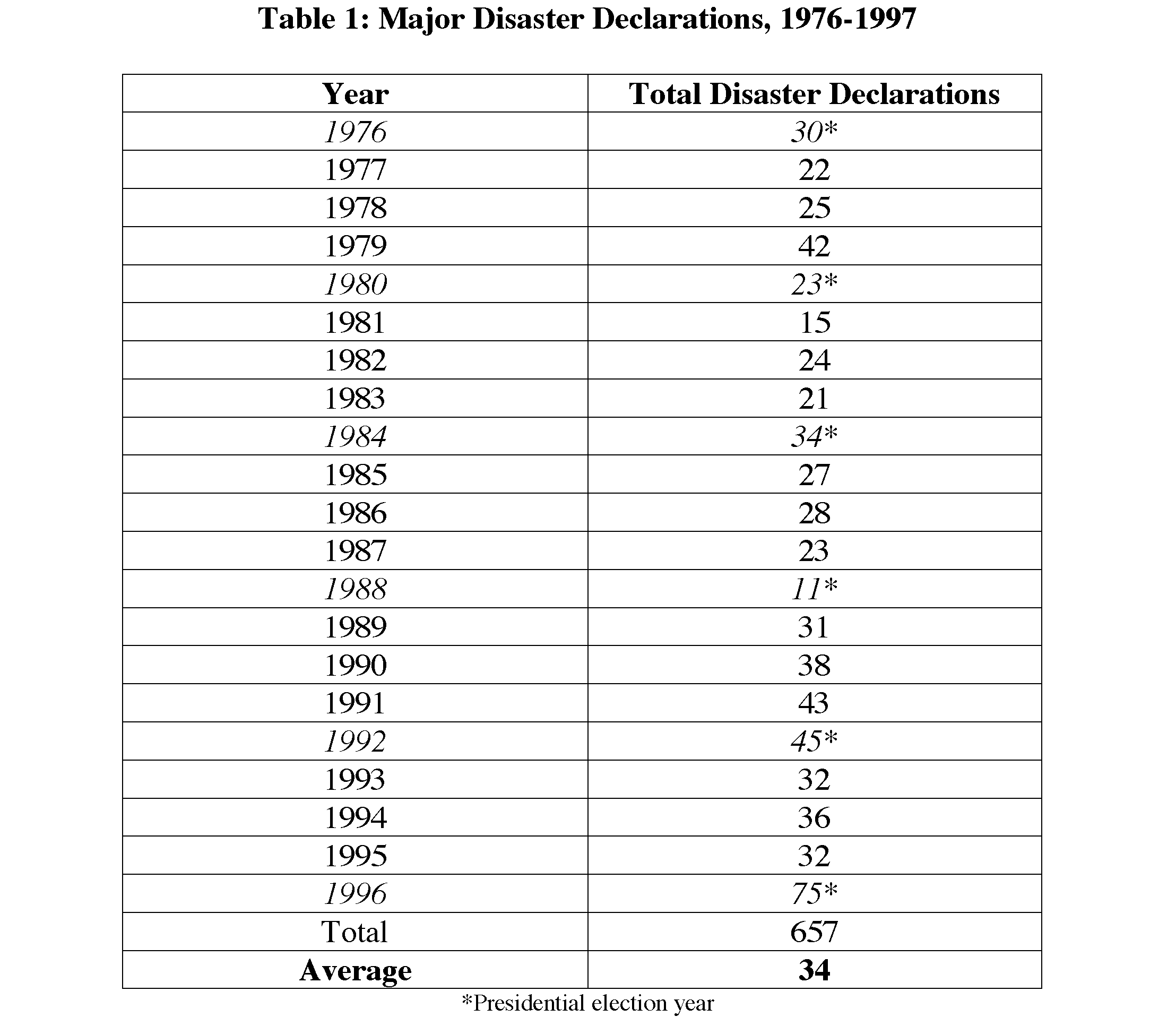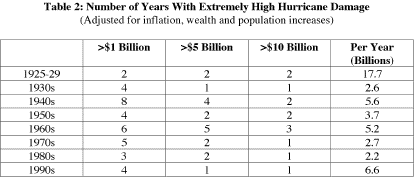01 Oct 1998 Environmentalists Erroneously Cite Government Pork-Barrel Spending as Evidence of Global Warming
Environmentalists continue to use every means of measuring the temperature of the planet except a thermometer. A case in point is the recent claim that the rising number of presidential disaster declarations – often used as a means of dishing out government pork rather than helping the needy – is a sign that the planet is warming.
At a recent press conference held to influence the November 2-13 global warming talks in Buenos Aires, Argentina, U.S. Public Interest Research Group (USPIRG) falsely asserted that the recent floods in Texas, alleged increases in natural catastrophe costs and alleged increases in extreme weather fatalities are signs that global warming is underway. Even more ludicrous, however, is that the group claimed that increases in presidential disaster declarations are caused by global warming. Noted USPIRG, “The average number of disaster declarations has increased from 25 per year between 1979-1983 to 46.6 per year between 1994-1998 – an 86% increase.”1
USPIRG wasn’t entirely honest with these statistics, however. For one thing, USPIRG selected periods of time for comparison that it knew would produce the most dramatic results. Natural disaster declarations are controlled not only by the weather, but by the person occupying the White House. From 1979-1983, during the Carter and Reagan Administrations, disaster declarations were significantly below their historic levels, while from 1994-1998, the Clinton years, disaster declarations were significantly above historic levels. During the 33-year period extending from January 1, 1965 to January 12, 1998, there were 1,198 presidential disaster declarations – equal to an average of more than 36 declarations per year, or 44% more than the average number made during 1979-1983.
USPIRG also didn’t take into account that presidential disaster declarations tend to be viewed by many Presidents – though not all – as a means of bolstering their re-election chances. There is nothing better than a photo opportunity of a President handing out money to disaster victims to help create the image that the Commander-in-Chief really cares for people like you and me. During four of the past six presidential election years, disaster declarations jumped above the norm (See Table 1).2

During his reelection bid in 1996, for example, President Clinton declared 75 disasters, more than double the average annual number of such declarations since 1964. Excluding that election year, however, President Clinton averaged just over 33 disaster declarations per year during his first term, three less than the 1964-1998 average.
It is worth noting that Jimmy Carter and Ronald Reagan stand out as the only two Presidents over the past several decades to declare fewer disasters during presidential election years than during non-election years. Jimmy Carter also lost his re-election bid.
As a former member of the board of directors of a university-based PIRG, which USPIRG represents in Washington, I am appalled that USPIRG would so blatantly misrepresent disaster statistics simply to win rhetorical points in the global warming debate. But this isn’t the only area where USPIRG has played loose with the facts in the global warming debate.
USPIRG also claims that the rising costs of natural catastrophes in recent years are a sign that global warming is underway. According to USPIRG, “Worldwide, the economic loss related to natural catastrophes in the last ten years is 8.5 times the cost in the 1960s.”3 This statement is extraordinarily misleading, however, because comparing losses in the 1960s and the 1990s is like comparing apples to oranges. While USPIRG at least went to the effort to index disaster costs to inflation, it did not adjust these figures to account for such factors as wealth accumulation and increased population. Much of the increase in natural disaster costs in recent years is due to the fact that there are more people, and thus more property (homes, office buildings, resorts, etc.), located in locations vulnerable to extreme weather events today than there were 20 or 30 years ago.
“[These figures have not been adjusted] for wealth and population,” says Thomas Loster of Geoscience Research Group Munich Re, the reinsurance company that provided USPIRG with its natural disaster cost estimates. “Of course, we are aware that these two things are most important…”4
Once disaster costs are adjusted for wealth and population, it becomes clear not only that these costs haven’t risen but are smaller than they were during the 1920s, when the planet was presumably cooler than today. A study released in January 1998 by Dr. Roger A. Pielke, Jr. of the Environmental and Societal Impacts Group of the National Center for Atmospheric Research and Christopher Landsea of the National Oceanic and Atmospheric Administration’s Hurricane Research Division, found that hurricanes, the costliest natural disasters in the United States, were nearly 2.7 times more costly from 1925-1929 than they were during the first five years of the 1990s, once population and wealth are factored in. (See Table 2)5

A further problem with USPIRG’s disaster cost figures is that they only measure insured property losses, not total property losses. They thus do not take into account the fact that the portion of insured property as a percentage of total property may have increased over the years. As the percentage of all property covered by insurance increases, one would expect that the amount of insurance claims would also increase, regardless of the incidence of natural disasters.
Environmentalists – including USPIRG – have also cited the loss of 374 lives to all natural disasters during the first six months of this year as evidence that the planet is warming beyond an acceptable level. As tragic as this loss of life was, however, it was not particularly unusual. In 1900, between 8,000 and 12,000 people in Galveston, Texas lost their lives as the result of a single tropical storm.6
Finally, USPIRG points to the recent floods in Texas, where as much as two feet of rain fell in a single weekend, as proof that global warming is occurring.7 Again, these floods weren’t record-breaking and thus don’t offer the kind of evidence of dramatic weather change USPIRG would have us believe they do. Texas’ record for rainfall occurred July 25-26, 1979, when, in a single 24-hour period, an estimated 43 inches of rain fell.8 Moreover, the 1995 report of the Intergovernmental Panel on Climate Change (IPCC), the United Nations body charged with coordinating a world response to global warming, states: “Overall, there is no evidence that extreme weather events, or climate variability, has increased in a global sense, through the 20th century…”9
If environmental groups such as USPIRG sincerely want to learn whether or not the planet’s temperature is rising they could try this novel approach: Use a thermometer. NASA’s thermometers in space have tracked the earth’s temperature for nearly two decades and show a slight cooling trend since 1979. Perhaps that’s the very reason environmentalists are using everything but a thermometer to measure the temperature of the planet.
David A. Ridenour is Vice President of The National Center for Public Policy Research, a Washington, D.C. think tank, where he oversees the group’s environmental program. Comments may be sent to [email protected].
Footnotes:
1 “Report Documents Deaths and Economic Loss From U.S. Extreme Weather: Group Calls for Strong Measures to Fight Global Warming,” U.S. PIRG press release, October 21, 1998
2 “Total Major Disaster Declarations,” Federal Emergency Management Agency, August 19, 1998
3 “Report Documents Deaths and Economic Loss From U.S. Extreme Weather: Group Calls for Strong Measures to Fight Global Warming,” U.S. PIRG press release, October 21, 1998
4 E-mail response to inquiry from Thomas Loster, Geoscience Research Group of Munich Re, October 23, 1998
5 Roger A. Pielke, Jr. and Christopher W. Landsea, “Normalized Hurricane Damages in the United States: 1925-1995,” January 28, 1998
6 Edward N. Rappaport and Jose Fernandez-Partagas, “The Deadliest Atlantic Tropic Cyclones, 1492-Present,” National Hurricane Center, May 28, 1995
7 Pauline Arrillaga, “Texas Floods Claim Family After Wedding,” Associated Press, October 23, 1998
8 “24-Hour Precipitation Maximums by State Through 1996,” National Climate Data Center, National Oceanic and Atmospheric Administration, 19989 Robert C. Balling, Jr., “Is Our Climate Becoming More Variable?” World Climate Report, July 16, 1998



